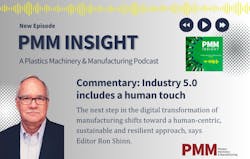When we think of the factory of the future, we often picture a fully automated facility with few workers. But manufacturing gurus are beginning to talk about Industry 5.0, a human-centric, sustainable and resilient approach, in which robots and humans do what they do best in tandem, rather than having machines replace people.
PMM Editor Ron Shinn explains why this may be the real future of manufacturing.
Transcript
We might have gotten it all wrong!
I have always envisioned the factory of the distant future being a lights out, fully automated facility where raw materials come in one end and perfect finished parts come out of the other end with few human workers needed.
It is the old joke that a lights-out plant will be run by just one human and one dog. The dog is to make sure the human does not touch anything.
But a recent article about Industry 5.0 indicates I might be wrong.
Manufacturing gurus are starting to talk about Industry 5.0, which is defined by author Micah Statler in Machine Design as building on Industry 4.0 plus adding a heavy emphasis on societal value and well-being. It represents a shift towards human-centric, sustainable and resilient approach to industry, focusing on prosperity beyond jobs and growth while respecting the planet’s limits.
What will that look like on the plant floor? It will be humans working alongside robots and smart machines to leverage technologies such as IoT and big data; supporting – not replacing – humans by recognizing the value of human intuition and problem-solving; and collaboration between humans and machines to optimize efficiency and sustainable growth.
Two points come immediately to mind. The first is that the plastics industry lags manufacturing in general in adoption of Industry 4.0. The second is that humans are going to be critical no matter how many robots and computer systems you buy.
Technology is certainly essential to the future of the plastics processing industry. Processing machinery makers have been pushing Industry 4.0 manufacturing processes for years now, with more success in Europe than in North America.
Robot manufacturers have been even more aggressively developing smart robots and cobots, but I still see very few cobots in plastics processing plants.
Senior staff reporter Karen Hanna has an excellent story in the June issue of Plastics Machinery & Manufacturing about how machinery manufacturers are embracing Industry 4.0 and smart technology in new equipment shown at NPE.
Industry 4.0 is described as embracing digitalization to create smart, interconnected factories. The Internet of Things and big data analytics are necessary for real-time production monitoring, more effective predictive maintenance, data-driven decision making and the optimization of operational efficiency.
So why have domestic plastic processors been slow to embrace Industry 4.0 and are not even ready to think about Industry 5.0?
You could argue that we think too much about the “now” and not enough about the “what could be.”
Business leaders in large and small companies have a short-term, quarterly profit mentality and find all sorts of reasons to avoid thinking about what their business will be like in five years. But if you don’t think about it now, how can you be competitive in five years? That also means smartly investing in new technology – and implementing that technology – to keep ahead of your competitors.
Two forces are currently colliding in plastics manufacturing. One is the adaption of digitalization and everything it enables. The second is an acute labor shortage. Could it be that the labor shortage is finally going to get North American processors moving more quickly towards Industry 4.0 and eventually Industry 5.0?
That brings me back to my initial point: Human workers are going to be more important in the future. Maybe you won’t need as many, but you will certainly need employees who can embrace and use the technology that will keep you competitive.
Senior reporter Hanna has written extensively about workforce issues and one truth she frequently finds is that successful companies identify, train and challenge their best employees. Those are the companies that will likely be thriving five years from now.
Is your plant ready to have people and machines collaborating in a way that optimizes productivity and achieves sustainable growth? That is a qood question to ask yourself.
You can read Micah Statler’s thoughtful article at www.machinedesign.com. He is the director of Industrial Technologies at Advanced Technology Services.
About the Author
Ron Shinn
Editor
Editor Ron Shinn is a co-founder of Plastics Machinery & Manufacturing and has been covering the plastics industry for more than 35 years. He leads the editorial team, directs coverage and sets the editorial calendar. He also writes features, including the Talking Points column and On the Factory Floor, and covers recycling and sustainability for PMM and Plastics Recycling.
